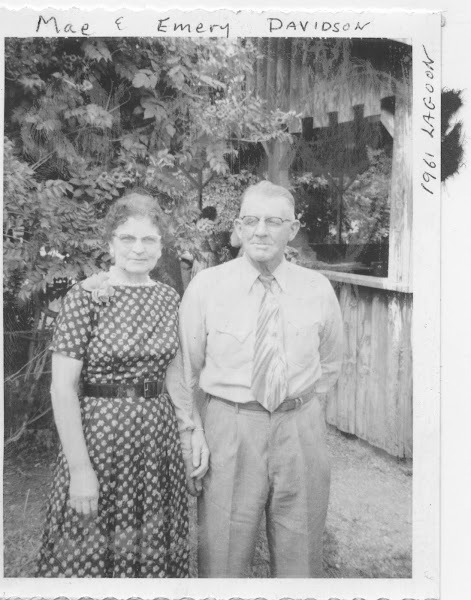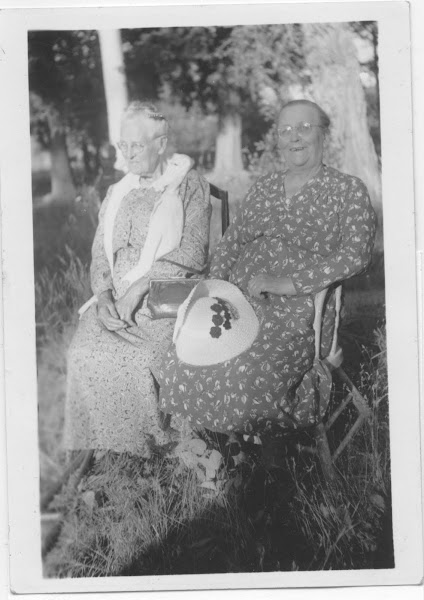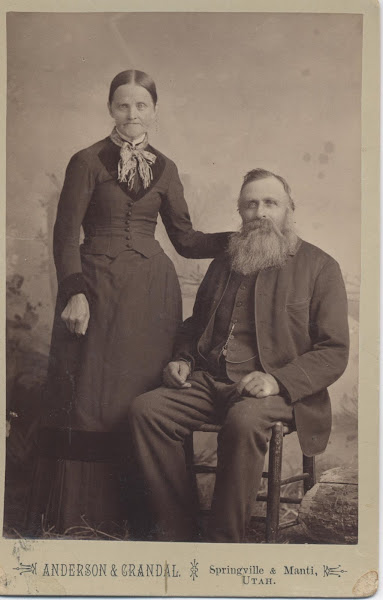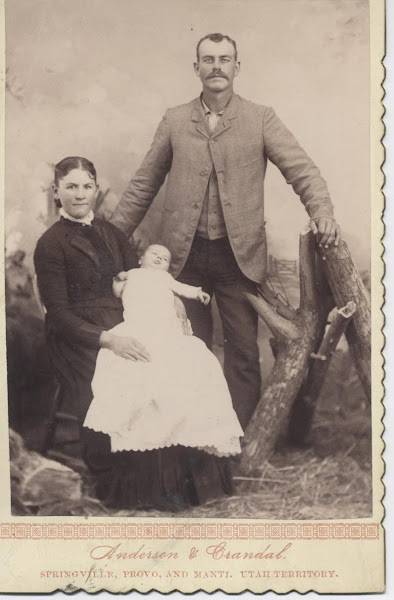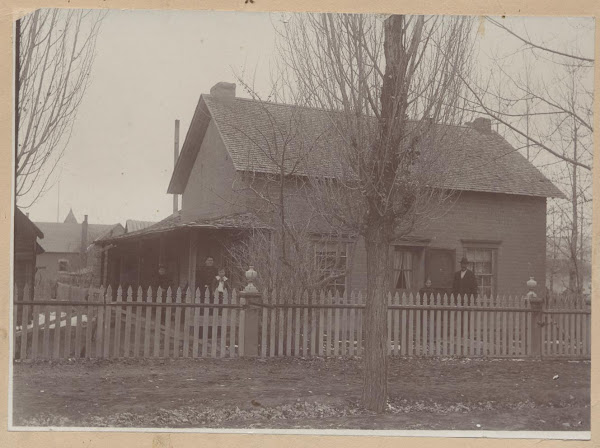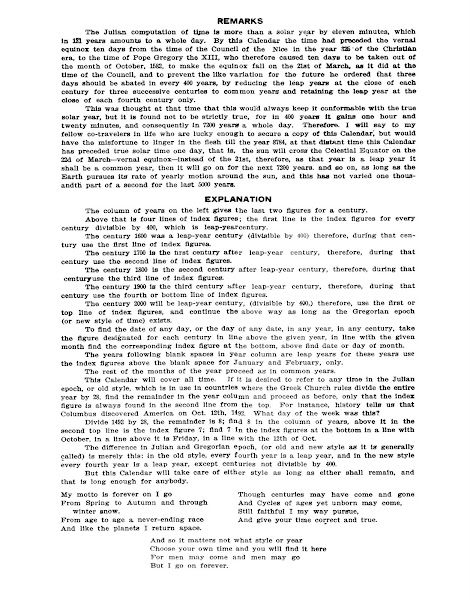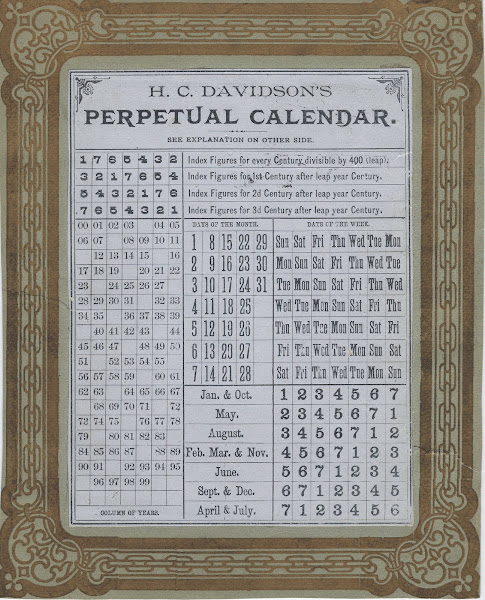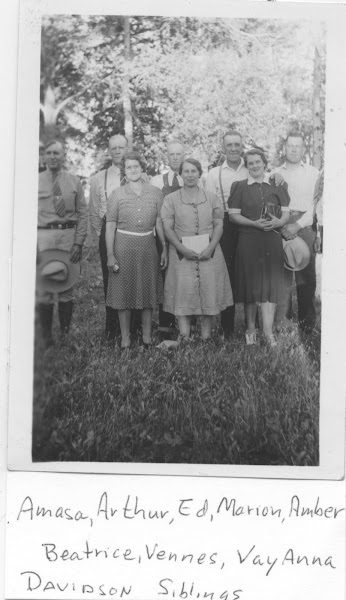Hans Christian Davidson (1820-1892)
(A history collected and annotated by Gwyn D. Davidson, a great-grandson).
I have gathered over the years a slip of paper here, a document there, a picture or snapshot--notes of a conversation had with or by one of my relatives--something about our wonderful ancestor, Hans Christian Davidson and have taken those bits and pieces and tried to weave a short but accurate history about him. It should be noted at the outset, that very little has been written or preserved about this wonderful person. Even less has been left to us about his wife, Anna Marie Jensen. What has been preserved is of great worth to their many descendents.
The sources I have used as a base for this history I have called "Document" for want of a better term, each with an identifying number (#). When a multi page document is used it will be identified as a "Document # with a page #. These can be found at the end of this work.
INTRODUCTION
When Hans Christian Davidsen came as an immigrant in 1858 to America, he used the Danish form of Davidsen, spelled with the letter `e' (Davidsen). After becoming an American he used the Americanized form (Davidson, spelled with the letter "o"). Hereinafter this history uses the name Davidson, spelled with the letter "o." To avoid redundancy the term or acronym "Hans or Hans C" or "Hans Christian" will often be used in lieu of "Hans Christian Davidson."
Hans Christian Davidson begins his own history by making the following personal statement: "[I] was born in Kekenes a peninsula in Alsen Schleswig, Germany on March 28, 1820. [I] married Anne Maria Jensen, daughter of Thomas Jensen and Catrine Margretha, (Document # 11) of Momark, Alsen, Schleswig, Ge. [Germany] [and] emigrated to America in 1858. (Doc. # 6, page marked 7)
"I first [located in] Battle Creek (now called Pleasant Grove, Utah County [and] [then] came to Mount Pleasant in Sanpete Co., Utah Territory in April, 1864. At the present writing (1889) we have 9 living children, the two oldest, Hans and Maria was [were]born in Alsen, before we came to America. SOLI DEO GLORIE." (Doc. #6, marked page7)
Hans Davidson also pinted the following :
"MY GENEALOGY, AS FAR AS KNOWN TO ME:"
"I, Hans C. Davidson, was the son of Hans Davidson, who was the son of Christen Davidson, who was he son of David Jorgensen. I was born on the peninsula of Kecknes per Alsen Island in the Duchy of Schleswig Holstein in North Prussia, on March 28th, 1820. [I] Was married to Miss Anne Maria Jensen of Moemark, Lysaple Church District on November 2°d, 1852. [I] was baptized into the Church of Jesus Christ of Latter Day Saints on November 16' , 1857. [I] emigrated to America and came to Utah in the year 1858." (Ibid)
Mr. and Mrs. Davidson lived in Moemark, for six years, the home town of Anna Marie. During this time two children were born to them- Mary and Hans. He had provided well for his little family in Denmark so that they lived comfortably and had a "nice little home of their own. " (Doc. #5, Pg. 1)
Hans C. Davidson's daughter, Sarah, in writing her father's personal history gives us some interesting sidelights about her father's profession and interests and pursuits. She states that her father was a draftsman, and drew plots of land, valleys and various buildings, and that he was "educated at the University of Copenhagen," that he was a photographer and scientist, a professor of science at the University of Copenhagen, and that he gave lectures . (Doc. # 2, p 1; Doc. #3, p. 1; Doc. #4, p 1; Doc. #5, p. 6).
It is obvious that Hans loved learning, science, and his books. The following statement by his descendant, Jeanette Davidson Hopkinson, states that "...what property and furnishings Hans Christian could not sell prior to emigrating from Denmark he gave away, carrying with him a ship locker filled with books, which were his prized possession." At his death in 1892 a local friend of the family wrote a letter to his son, Lorenzo' asking what he should do about "...his books-- how shall we best divide them?" He
carried his books clear across the Atlantic, and over the Great American plains to the Territory of Utah. He loved his books; he read them and studied from then. His books served him well. (Doc. # 13, pg. 1; Doc. # 16)
EMIGRATING TO AMERICA IN 1858
Hans Christian Davidson was born early in the Spring of 1820. His birth was at the very same time that The Prophet Joseph Smith had his miraculous First Vision (Early Spring 1820) which was presented to him by the Eternal Father and his son, Jesus Christ. The Prophet Joseph was instructed by them and in time the true Church of God was organized in America in April, 1830.
Sometime in the year 1857, a missionary elder from America, Elder Ivan N. Iversen from the Church of Jesus Christ of Latter-Day Saints began teaching his wonderful message of the above described vision. He contacted the Hans C. Davidson family and explained to them the truths of the Restored Gospel. Both Hans and his wife Anna Marie were converted to his message and were baptized in November 1857. According to their daughter Lucinda, They were the first converts in their city. (Doc. #1)
The family of Hans Christian Davidson turned against him. He was forced to study his religious books in secret and when not studying them he hid them in a nearby hill. His stash was discovered by the authorities and he was sent to prison where they fed him on a criminal's diet of bread and water. While in prison he asked if he could have a Book of Mormon to read, but his request was denied him. However the prison authorities did allow him a hymnbook to read. Because of his religious beliefs he was ultimately banned from Denmark. (Documents: #1, and #2)
Shortly after the Davidsons' baptism and uniting with the Church, their friends and relatives became very angry with them. They could not understand why these two converts would want leave a comfortable home, and a promising career and their family in Moemark, Denmark and go on what seemed to them a foolish trip to a far away country. Suffering the ridicule of relatives, neighbors and friends, they sold their "nice little home" and disposed of their household goods as best they could. Taking only what clothing and bedding and food enough for their immediate needs they began their six thousand mile odyssey to a new land- America (Doc # 6)
Because of difficulties caused by the Lutheran Church, the police, government authorities and disgruntled family members these converts and others quietly decided to come to America anyway and make Canada a temporary abiding place until the difficulties [often called the Utah War] at Great Salt Lake City in Utah Territory should blow over. This group of Danish Mormon convert emigrants started out from Denmark on the 21 S` of February, 1858 and proceeded overland to Hamburg and thence to Bremerhaven, in Germany where they arrived 12 days later, on the 4th of March after a somewhat difficult journey. This group of about eighty Scandinavian emigrants now added ten English converts making the total number ninety who were under the direction of Elder Ivan N. Iversen, a returning missionary. (Doc. #3, pg 6; #14))
All of the sisters of Anna Maria Jensen turned their backs on their sister and fully "forsook her" However one sister, followed her for more than 100 miles to the ship without speaking a word to her. She was at the dock to quietly wave her sister "Bon Voyage." and was the only relative to see them off. (Doc: #2, #3 #8)
No resistance was offered to these emigrants in leaving their fatherland. This group arrived without difficulty-due to a quietly prepared pre- arranged meeting place. (Doc. #8, pg. 1) at Bremerhaven, Germany, on the North Sea. They began their sea voyage and set sail aboard a small steamer, named MOVE. The date was March 5, 1858. However this small ship had to return to port after four days of fighting a storm and contrary winds on the North Sea. After a delay of three days, this little steamer with its precious cargo set sail again for Hull, England on March 12 and arrived at Hull on the 14 `h of the month. They had been traveling for 22 days and they were still in continental Europe. (Documents: #l, #2, #4)
This group of Mormon Saints then took the steam train at Hull and in one long day crossed the British Isle and arrived at Liverpool, that evening. They were now on the west coast and had a good look at the mighty Atlantic -- their next challenge -- 3,000 miles of ocean. Here they boarded the barque [a three-masted sail ship],JOHN RIGHT on March 18`h and laid in the river for four days until the right tides and breezes came. They set sail on March 22, 1858. They had now been gone more than .a month and they had just barely left England. It took them 31 days to cross the Atlantic and they ran short of clean uncontaminated, drinkable drinking water.
Because Hans Christian Davidson and his family were very poor, they could only purchase steerage (third class) accommodations. That meant that they furnished their own food, cooking, and bedding. They lived in and slept and cooked in lower berths where vomit and raw sewage mixed with chicken, pig and goat droppings made such a trip less than pleasurable. Water supplies ran out and many people suffered. Three persons died in the Atlantic crossing. (Documents #2, #3 and #14)
The ship docked at Castle Garden, New York on Saturday April 24, 1858 after 31 days of sailing on the high seas. (Documents #2, #3, #8, #9:1-2)
THE FOLLOWING WAS PUBLISHED IN THE NEW YORK TIMES OF THIS DATE, APRIL 26, 1858
"ARRIVAL OF SCANDINAVIAN MORMONS IN NEW YORK
What they say of Mormonism in Denmark, Sweden and Norway"
"A company of ninety Mormons, eighty one of them from Sweden, Denmark and Norway, and nine from England arrived at this port on Saturday, on board of the emigrant ship JOHN BRIGHT, Capt. O'Conner. The Scandinavian portion of this company had their rendezvous at Corsoer, in Denmark, where seventy eight adults and children, from different conferences or districts of the country over which the Mormons are scattered in small communities, each presided over by an elder, assembled on the 201h of February last, called together by the president of the Mission, Elder Carl Viderborg. The Mormons of Europe, previous to the present disturbances in Utah [the Utah War], have been constantly preparing for emigration, and emigrating to Great Salt Lake City. The new converts to the faith, as soon as they could collect sufficient means, were in the habit of setting out immediately for America."
"The members of this Scandinavian company, most of them tradesmen and mechanics, having converted their property into money with intention of emigrating, heard of the disturbances in Utah last fall, and at first hesitated whether they would start for the new world or not. It was finally decided that they should come to this country and make Canada their temporary abiding place until the speck of war in the west should blow over ...."
"The ship, John Bright landed at 11:00 Saturday morning at Castle Garden, ... and then the Mormon emigrants went to Walker's Hotel, No. 25 Greenwich Street where quarters had been provided for them by their Mormon friends in this city. Our reporter visited [with a few of the travelers] last evening. But few of them could speak English, and Miss Olivia Nielsen- one of their number- translated what information they had to convey to him concerning themselves and the condition of Mormonism in the Scandinavian countries. The interpreter said, 'The captain, as well as the other officers, and indeed the whole crew showed us all possible respect and kindness, and we cannot but feel satisfied with the treatment we have enjoyed."
"...The number of other immigrants on the ship amounted to about 640English, Irish, and German. The company consists of two persons from Norway, seven from Sweden, four from Schleswig (a German province belonging to Denmark) and all the rest from Denmark ...."
"Among the male portion of the emigrants are a number who have taken a leading part in propagating Mormonism throughout Denmark, Sweden and Norway. Some of them have been several times imprisoned by the `Politie' or police, in Sweden for baptizing converts to Mormonism. One of them, Lars Jorgensen, was imprisoned eight times in Holland and Malma, Sweden. Another, Niels Paulsen said he was in prison in Norway six times for baptizing contrary to the Lutheran creed. In the German part of Denmark, the province of Schleswig , where Mr. Iverson had his mission, " the interpreter said, The Lutheran Church prevails to the exclusion of every other, and those inhabitants who join any other sect or adopt any other faith ....not having the same liberty as in the other parts of the Danish States, are persecuted, imprisoned, heavily taxed and sometimes banished as was the case with one person of this small company, Mr. Davidson, who after having being put in prison, and several times being tried by the police, was made to pay fines, and threatened with banishment, and at last forced to sell his little farm at a very small price, and he and his family were glad to join the company of Mr. Iversen. During the time Mr. Iversen stayed in Denmark, Mormonism has made considerable progress, not only there but everywhere in Scandinavia ....The majority of the emigrants are females. None of the men have more than one wife and many of them have none. They are generally very intelligent -looking. The following are the names of those who compose Eder Iverson's company:
"I". N. Iverson, C. A. Madsen, C. V. Madsen, C. O. Folkman, Elia Folkman, C. D. Fjeldated, K. Fjeldated, P. I. Fjeldated, Vita I. Fjeldated, Willard Fjeldated, I. M. Petersen, P. Jorgensen, Louise J. Jorgensen, Marie Jorgensen, Jene Jorgensen, Cecilie Jorgensen, Karoline Jorgensen, M. Christensen, Niela Petersen, Kirsten Petersen, Ane Petersen, Niels Petersen, Marie Petersen, Ane Maria Petersen, Ole Sonne, Cecilie Sonne, M. C. Christensen, Stina Christensen, M. C. Gregersen, Ana Andeersen, M. Andersen, R. Olsen, P. O. Meilhede, Maren Meilhede, K. Sorensen, A. Nielsen, Bodil Nielsen, P. Jonsen Kirsten Johansen, H. Nielsen, J. Andersen, Karen Andersen, Maren Andersen, Kirstene Andersen, Anders Andersen, Anthon Anderson, Olivia Nielsen, L. Sorensen, K. M. Petersen, K. Svendsen, Maria Petersen, Christian Petersen, Peter Petersen, Joseph Petersen, F. Christensen, H. P. Olsen, H. P. Lund, N. C. Paulsen, A. P. Oman, N. Edler, L. Jorgensen, J. Lareen, Caroline Larsen, C. Petersen, A. Hansen, Magdalena Hansen, Karen Hansen, H . Knudsen, H. C. Davidson, Anne Marie [Ane] Davidson, Anne [Mary or {Marie], Hans Davidson, C. Rasmussen, Thea Hastrup, Maria Hastrup.
The progress of Mormonism, the emigrant `Saints' assured us, had been very rapid in the Scandinavian countries, during the last few years.
--NEW YORK TIMES, April 26, 1858"
According to the news reporter from the New York Times, who visited this ship and met with many of the travelers, reported; "this voyage was a pleasant one;" and they had "only a few days of stormy weather." (Doc. # 3, pp 1-8)
TRAIN TRAVEL IN AMERICA
Two days after having arrived in New York the Davidson family hurried to get all their personal affects and then scurried to the train depot. Here they boarded a somewhat newer form of transportation- a modern rail car that rode on steel rails and was pulled by a steam locomotive. On such they tried to rest and relax after so much sea travel. However, There was no way to relax. There was no such thing as a Pullman car. The only amenities offered by the railroad were straight backed hardwood railroad benches or seats, One could only sit for a time, and then there were stops to make-plenty of them. Children require many stops. The Davidsons were like the other travelers- they had to eat and fix their meals on the train with what was available to them. as they went form town to town.. They passed through Buffalo, Cleveland and Chicago. The Davidson family having left New York on Tuesday April 27. rode the "iron horse" for 6 days until they came to the end of the line-- Iowa City, Iowa. They had covered a distance of 1100 miles in 6 days under many uncomfortable travel conditions. They had two options -travel in a sitting position, or if permitted just lying on the floor while traveling. The arrival date was May 1, 1858. (Doc. #7)
Iowa City was the gathering place of many travelers headed for California, and the Northwest. It was also a gathering place for the Mormon Pioneers who were headed for Great Salt Lake City and more often than not, there were agents of the Mormon Church stationed at this important city to assist and guide the travelers. Of the ninety or so emigrants who were under the direction and supervision of Ivan N. Iversen more than half were returning missionaries, and were unmarried and single (Doc. #14,-2). The matter of the group remaining intact was discussed. Since they had no children, they could go faster than could families. It was decided to dissolve the ranks and permit the singles to travel on their own. These young men, missionaries, bounded for home and loved ones made good travel time as they headed west and arrived at Great Salt Lake City on July 9, 1858. . It is unknown how they traveled, in handcarts, or wagons or whatever The records do not tell us. But it appears that because these were (I) young men, (2) and single, (3) with no families to delay them, and (4) the availability of used but good handcarts, they traveled from Iowa City to Great Salt Lake City, via handcart a distance of more than 1170 miles, in a little over 2 months. (Ibid)
At Iowa City Hans Christian and his little family alighted down from the train with the others and waited for further instructions from Elder Iversen. The wait lasted until the middle of June, 1858. This 2°a group was made up of about 50 persons -a few marrieds, a few singles, but mostly families. This group was made up of those remaining Scandinavian emigrants who had left Denmark five months earlier that year. Hans C. Davidson and his family found themselves with this second group. They left Iowa City about the middle of June by ox team heading for Winter Quarters on the Missouri River and 245 miles to the west. (Doc. # 7). We do not know how Hans Christian fared with these animals, and their carts, for they were all new to him. We do not know who owned them, or provided them, or paid for them. Perhaps the 6-week wait had a positive effect on the small wagon train.- providing the means whereby all the participants- the poor, the tired, the worn out, the sick, those heavy with pending births, the families with small children, and the hungry could continue on to see their Zion.
CROSSING THE PLAINS
Our interest now focuses on the second or middle group- the main body of pioneers who were now at Florence (Dakota Territory, now called Nebraska) next to Winter Quarters with 924 miles yet to go to Great Salt Lake City. "There were about fifty of the group, who by July had found means to travel on to Utah. The Davidson family was impatient [anxious] to be on their way so arrangements were made that Maria would take the two children and a few possessions and necessities in a [horse-drawn] handcart along with a few other Saints and accompany the few wagons which were making the trip." This group was made up of only eight wagons (Doe. #7; # 8. pg 1; # 15) and a few hand carts, which, to say in the least was very dangerous and very vulnerable.
"Our grandfather, Hans Christian had discovered that there was an army detail also going west at the same time and there was a job herding mules for which he could receive a small fee and his food. He knew very little English and nothing at all about mules, never having seen one before. However, he was brave and applied for the job." (Doc. # 8, page 1)
The herding job came as a blessing in disguise. He was fed a full meal each day And he was able to earn a little cash for his employment. Hans Christian did not travel directly with his wife and children, but worked with the other men who were also herding mules, and he was not too far from them. (Doe. #6 pg 2; doe # 12 pg 2) see also 14: 3
The net result is that our grandmother, Anna Marie traveled to Great Salt Lake City, in the small wagon train of eight units, walking all the way while leading Elder Ivan N. Iversen's horse and cart. The father, Hans Christian, the engineer and practical scientist rigged the handcart so that a horse could be harnessed in such a fashion that it did all the pulling of the cart and its contents.. The mother then could take charge guiding the horse, and caring for the children, (ages 3 and 5 years) who rode on top of the cart with all their household goods. Sometimes... "the children were distributed among the wagons to equalize the loads and care, the mothers saw them seldom except at mornings and night." (Doc. #3, pg 3)
(Little is known about the third emigrant group. They came later from Winter Quarters and arrived in the Salt Lake Valley October 7, 1858; Doe. #7).
This was truly "going it alone." or, on the other hand, placing one's children, husband, one's own life and all one's worldly goods in the hands of God and trusting Him. And so the saga was: one family, split into two parts, with a lone woman at the head, two small children to mother, with no men to do the heavy work; traveling in Indian territory, nine hundred miles still to go, and at the best, eating humble rations and subsisting on very little food and sharing it with two small children and a very tired mother.
The Davidson family, together with the very small pioneer wagon train, left Florence, Nebraska on July 6 and arrived in Great Salt Lake City on Monday, September 20, 1858. Anna Marie Jensen Davidson, age 31, had crossed the Great American Plains on foot, alone, while leading Ivan Iversen's horse and cart! "The family was happily reunited in Salt Lake City ...." (Doc # 8, pg 1)
ANNA MARIE JENSEN DAVIDSON
Anna Marie Jensen knew how to sacrifice for her children and they have left us an indelible record for us to consider of their mother:
Anna Marie:"...walked the entire distance often leading Captain Iversen's horse ...." Doc. # 2, D.U.P.
"...led Captain Iversen's horse and cart ...walked the entire distance' ...."Doc. #3, S. D. Wilcox and H. T. Wilcox, V. Jensen
"Mother led Capt. Iverson's horse and cart while she herself walked the entire distance." Doc #4, 14 Sarah Wilcox
"Mother led Capt. Iversen's horse and cart while she herself walked the entire distance."Doc. #5 Sarah D. Wilcox and Vennes Jensen
"Mrs. Davidson led Capt.. Iversen's horse and cart across the plains, walking all the way ...." Doc. # 6) Sarah D. Wilcox
enroute Maria endured the many hardships of the road and grew weary almost beyond endurance. She had to swim the Platte River with the hand cart containing the children floating ...." Doc. # 8 Jenette Hopkinson
"It was agreed she would take her handcart and two children and travel with Ivan N. Iverson's wagon train... [and they would] help and assist her as best they could .... Doc. # 13 Hopkinson
"...Anna Marie had to swim over a small but deep eddy, pushing her handcart with the two small children riding on the floating cart." Doc. # 13 Hopkinson
Her children have told us [above] in many ways that she truly accomplished that fete -- she crossed the Great Plains on foot and alone! They are also telling us that it is something that we should not forget!
IN ZION
After a short, but welcomed rest Hans Christian and his loyal and faithful wife Anna Marie took their family out of Great Salt Lake City, and moved 24 miles south to Battle Creek, being encouraged to do so by Elder Ivan N. Iversen the missionary, who lived there.. (Today we call the place Pleasant Grove). "The first dwelling place for Mr. and Mrs. Davidson was a cellar given them (to be used by them temporarily) by Mr. Iversen. The family endured a very severe winter... in their cellar home." (Doc # 3, pg 3)
"Many times they had to go to bed to keep from freezing to death. Hans Christian's heels were frozen and became swollen and raw, with scores of sores the size of dollars on them." (Ibid.) During the time the family lived in Battle Creek four children were born to them: Lorenzo, Bell (or Isabel, or Elizabeth), Amasa and Sarah" (Ibid.) Baby Sarah died as a babe only six months old. The family was very poor, when Bell was born they had no clothing for it. A neighbor lady seeing the destitute condition of the family, went to a daughter who had previously lost her baby and they immediately brought some of the baby's clothes to her. (Ibid)
After Davidson's family emigrated to America his enthusiasm for work and being productive did not wane. He worked in the flax fields in Utah County. Here he invented a machine to process the flax. The family helped in the processing and made such flax items as rope, thread, candles, shoe laces, kites and a host of other things. (Doc. #5 pg 2; # 6,pg 2)
About this time Hans Christian borrowed a neighbor's hay wagon and began a trip Salt Lake City to sell some hay.. There were two roads at the time at the Point of the Mountain. The upper road led north and down to a sharp point (hence, the Point of the , Mountain). The lower road was southbound and near the Jordan River. He had two yokes of oxen hitched to his wagon. Somehow the lead team became unyoked and they fell down the steep 300 foot slope. The other yoke, wagon, hay and driver all fell down the steep slope and landed near the Jordan River. Hans badly injured. He had a broken jaw. Three oxen were dead. He was picked up by a passerby and carried home, but he suffered deeply from his injuries. The one living ox also had a broken jaw and walked home. They saved the ox by nourishing his injuries by gently feeding it soft mashed potatoes. (Doc. #4, 2; 5; 2)
"Hans C. worked hard and was given a ham in payment for some work he had performed, which ham had a value of fifteen dollars. By carefully rationing it the ham lasted all summer. (Ibid.) Hans Christian was a good father and a good leader, and he taught his children to work. In time he purchased a small farm in Battle Creek. He had the farm for less than four years and he paid off the debt of the farm in full.
A fellow Scandinavian, Peter Godferson urged Hans to sell out in Battle Creek and move south to Mt. Pleasant, about a hundred miles away. In 1864 Hans did in fact sell out and purchased a 27 acre farm in Mt. Pleasant- and he did so for $1,000.00, in cash, and in full. Never again was Hans Christian in debt to another person.
While they lived in Mt. Pleasant, four more children were born to them: twins, Ephraim and Sarah, Lucinda and Joseph. (Note: the first daughter named Sarah died while they lived in Pleasant Grove, hence the twin named Sarah is the second daughter they named Sarah.)
A list of some achievements of Hans Christian Davidson is appropriate here:
He gave lectures on science and astronomy:
He was a photographer
He published his own newspaper
He was first to import alfalfa seed in Sanpete County
He built a player piano
He invented a sorghum press
He developed a perpetual calendar
He performed some minor dental surgeries
He spoke three languages well: Danish, German and English
He did job printing until he died
He was a good and decent human being
He was a good and faithful Latter-day Saint
He was a good husband
He was a good father
He taught his children the blessings of work
His daughter, Sarah tells us that he "cared more for studying than for the material comforts of life." .Doc. # 6, 6
SOURCES
(1) Telephone conversation with daughter Lucinda and Mary Davidson, ca 1945
(2) Author unknown, copy of a "History of H. C. Davidson" from DUP
(3) "History of Hans Christian Davidson by Sarah D. Wilcox, [a daughter] H. T.Wilcox and Vennese W. Jensen, Mt. Pleasant, Utah, 1932
(4) Biography of Hans Christian Davidson by His daughter, Sarah D. Wilcox
(5) Biography of Hans Christian Davidsoon & Wife, dictated by [their] his daughter,Sarah D. Wilcox and written by her daughter Vennes Jensen
(6) Hans Christian Davidsen & Family History, by Sarah D, Wilcox ca., Mt.
Pleasant, Utah 1889
(7) "History of Grandfather Davidson" From "History of the Scandinavian Mission" by Jensen,
(8) "My Grandfather, ,Hans Thomas Davidson" by Jeanette Davidson Hopkinson, Evanston Wyoming cc. 1925
(10) 2 pages "Biography of Hans Christian and wife" (Unknown author)
(11) Genealogy Family Group sheet of H. C. Davidson family,
(12) "Genealogy Card of Hans Christian Davidson" Author Unknown, copy DUP
(13) 2 Pages of "Hans Christian Davidson, edited by Gwyn D. Davidson, from a document by Jeanette Davidson Hopkinson
(14) "History of Hans Christian Davidson", includes sail ship list of passengers And misc accounts of sailing to America
(15) Misc document, half page, identifies number of wagons in Iverson's wagon train Author unknown
(16) Personal letter from Neils P. Neilson to Lorenzo, a son of H. C. Davidson, 1893
Hans Chistian’s wife, Anna Marie Jensen died 2 May, 1886
Hans Christian Davidson died 23 August, 1892
Hans Christian Davidson lived in the small home at 79 North State, Mt. Pleasant, Utah until he died
I am honored to write this history about my grandparents and bring to light something of their lives that has been forgotten for too long. I think I know them a little better now, than when I first began this study. I would like to be more like them. If I can do so, I will be the better off for it.
Gwyn D. Davidson;
Draper, Utah; December 7, 2009





